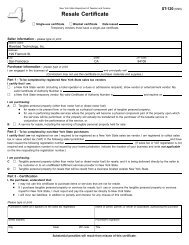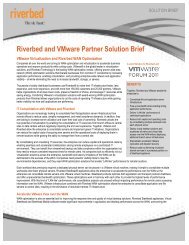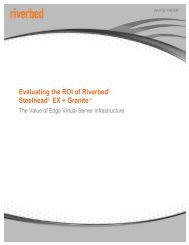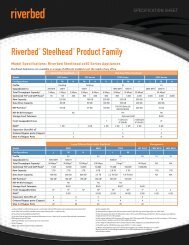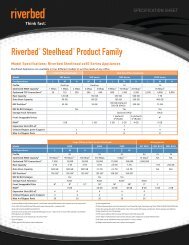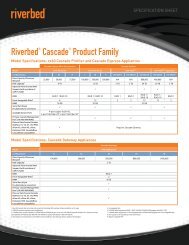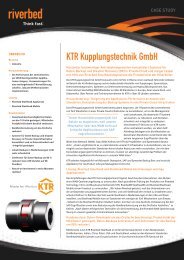Riverbed Optimization System (RiOS) 6.1
Riverbed Optimization System (RiOS) 6.1
Riverbed Optimization System (RiOS) 6.1
Create successful ePaper yourself
Turn your PDF publications into a flip-book with our unique Google optimized e-Paper software.
<strong>RiOS</strong> Technical Overview<br />
alerts such as user login/logout, configuration changes, TCPDump started, etc. The API allows a broad set of reporting and<br />
management actions to be taken from external Network Management <strong>System</strong>s (e.g. HP OpenView). Most statistics are exposed<br />
and a number of configuration actions can be taken remotely. Collectively, these tools allow for easy management of the<br />
appliances and straightforward integration into existing network management systems such as HP OpenView.<br />
Simplifying configuration even further, the patent-pending <strong>RiOS</strong> auto-discovery capability automates the establishment of<br />
optimization peering relationships throughout the enterprise. This gives large firms a method to efficiently scale WAN optimization<br />
deployments globally without creating additional complexity and overhead. Auto-discovery also enables easy integration with “anyto-any”<br />
networks, which is common to many of today’s WAN architectures, thereby circumventing problems specific to tunnelbased<br />
optimization technologies.<br />
Steelhead Mobile software installations overcome many of the challenges with deploying client software packages. The solution<br />
comes with an MSI package builder to construct installations and upgrades, which can then be installed using deployment<br />
software such as SMS, Altiris, LANDesk, or other solutions. In addition, installs can be performed using a silent installation mode<br />
so users do not need to engage with the installation process.<br />
Comprehensive Network Visibility<br />
By providing outstanding network visibility, <strong>RiOS</strong> ensures that its application acceleration capabilities do not cloud enterprises’<br />
reporting capabilities. <strong>RiOS</strong> technology can automatically assign application names to port numbers, allowing users to quickly see<br />
what applications are driving traffic across the WAN. Reports will also show per application stats for traffic that is passed through<br />
un-optimized. Finally, Steelhead appliances and Virtual Steelhead can show acceleration per <strong>RiOS</strong> QoS class (if QoS is enabled<br />
on the appliance).<br />
<strong>RiOS</strong> also provides the ability to export detailed real-time flows from a Steelhead appliance, Virtual Steelhead or mobile client to<br />
Cascade or a third- party NetFlow v. 5 collector for greater visibility, analysis and diagnosis of issues. From the NetFlow collector,<br />
enterprises can view byte counts per port, per src/dest IP address, and from a specific interface. IT administrators can obtain<br />
traffic views for optimized vs. pass-thru traffic separately or in aggregate and obtain top talker/listener tallies from a NetFlow<br />
compatible collector. In addition, NetFlow v. 9 is supported and the newer flexible formats allow us to export all the data a<br />
customer needs to build a site report (inbound and outbound LAN and WAN traffic) from a single Steelhead appliance or Virtual<br />
Steelhead. This will provide the information that<br />
Cascade and other external reporting solutions need<br />
to generate reports without needing to correlate data<br />
from multiple flow sources.<br />
Figure-13: Traffic visibility and optimization from the Central Management Console<br />
Pass through traffic reporting gives visibility into<br />
which connections are being optimized and which are<br />
not. It further qualifies the reason for pass through,<br />
whether this is due to the protocol (UDP, VoIP, etc.)<br />
or because the maximum capacity or number of<br />
connections for the Steelhead appliance model was<br />
exceeded.<br />
<strong>Optimization</strong> benefit reporting helps quantify the<br />
improvements on WAN made by <strong>RiOS</strong> features such<br />
a application specific and TCP latency features. This<br />
detailed report can show the number of roundtrips<br />
saved as well as the reduction in data.<br />
© 2010 <strong>Riverbed</strong> Technology. All rights reserved. 17



